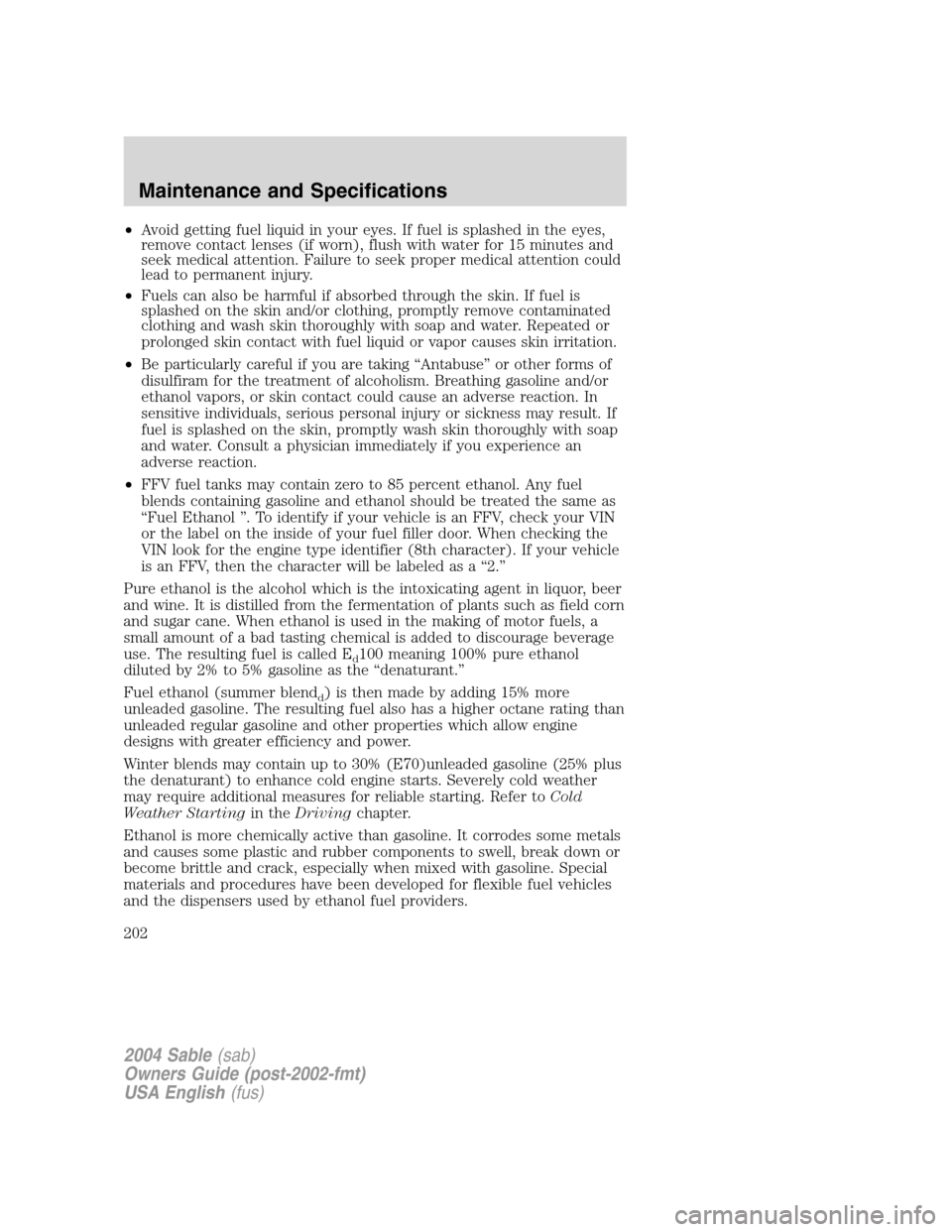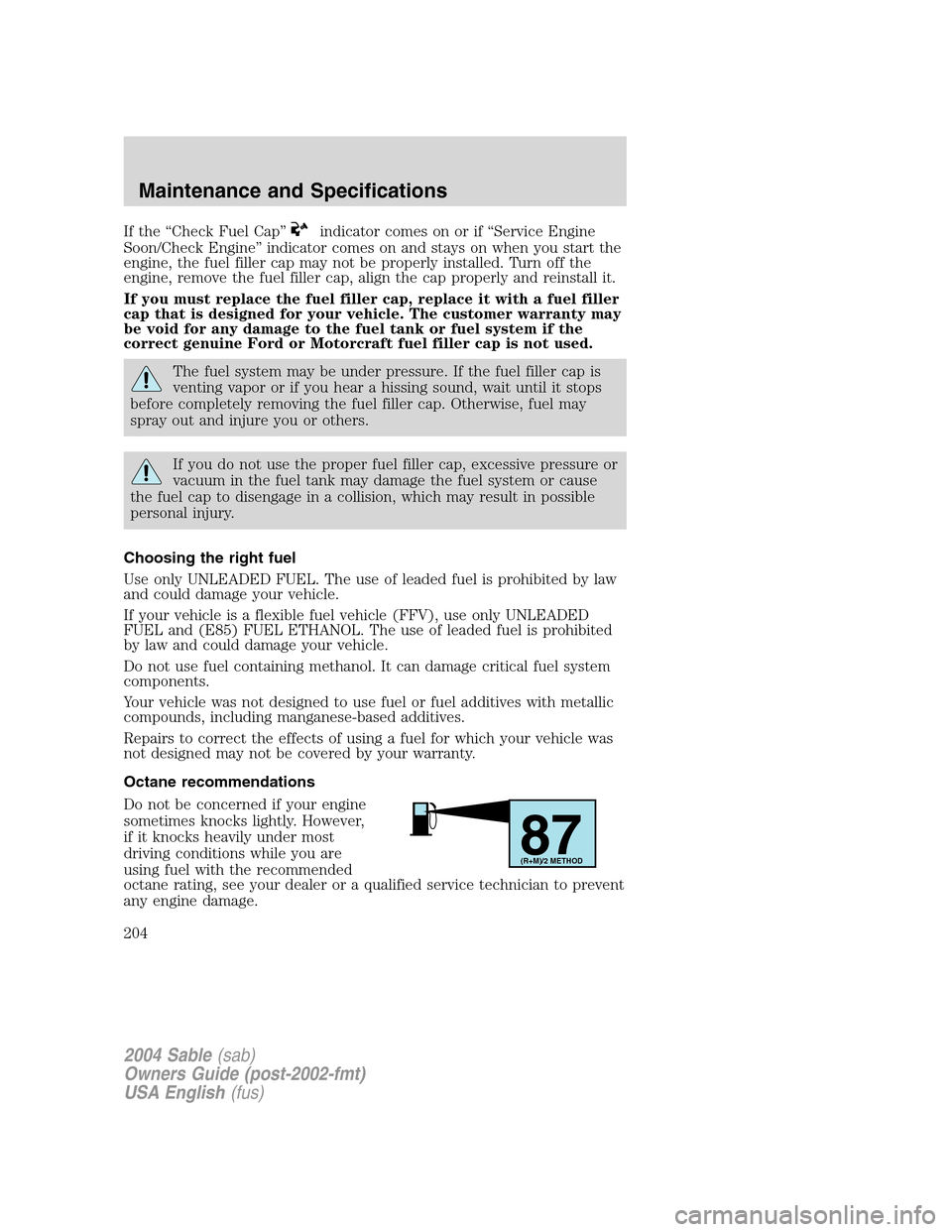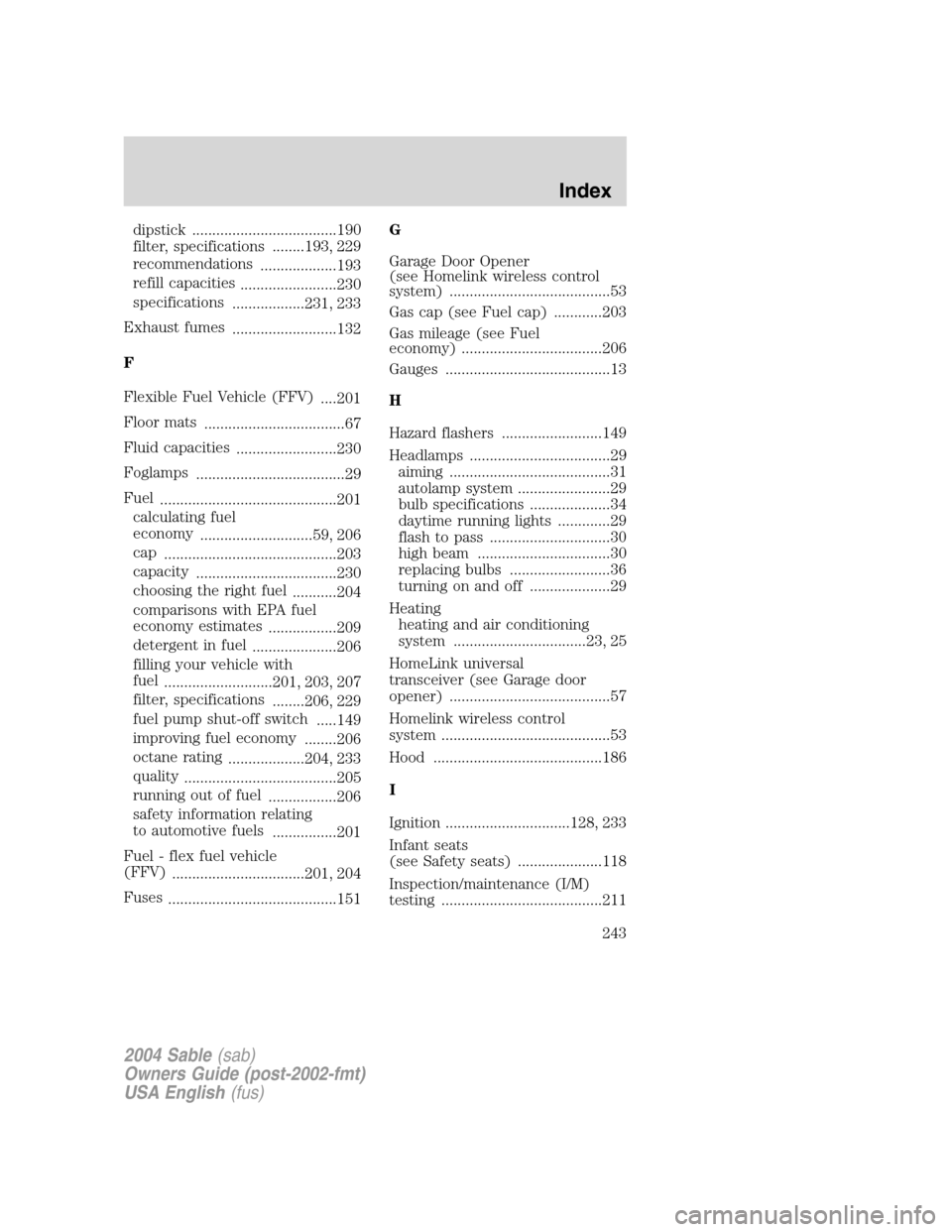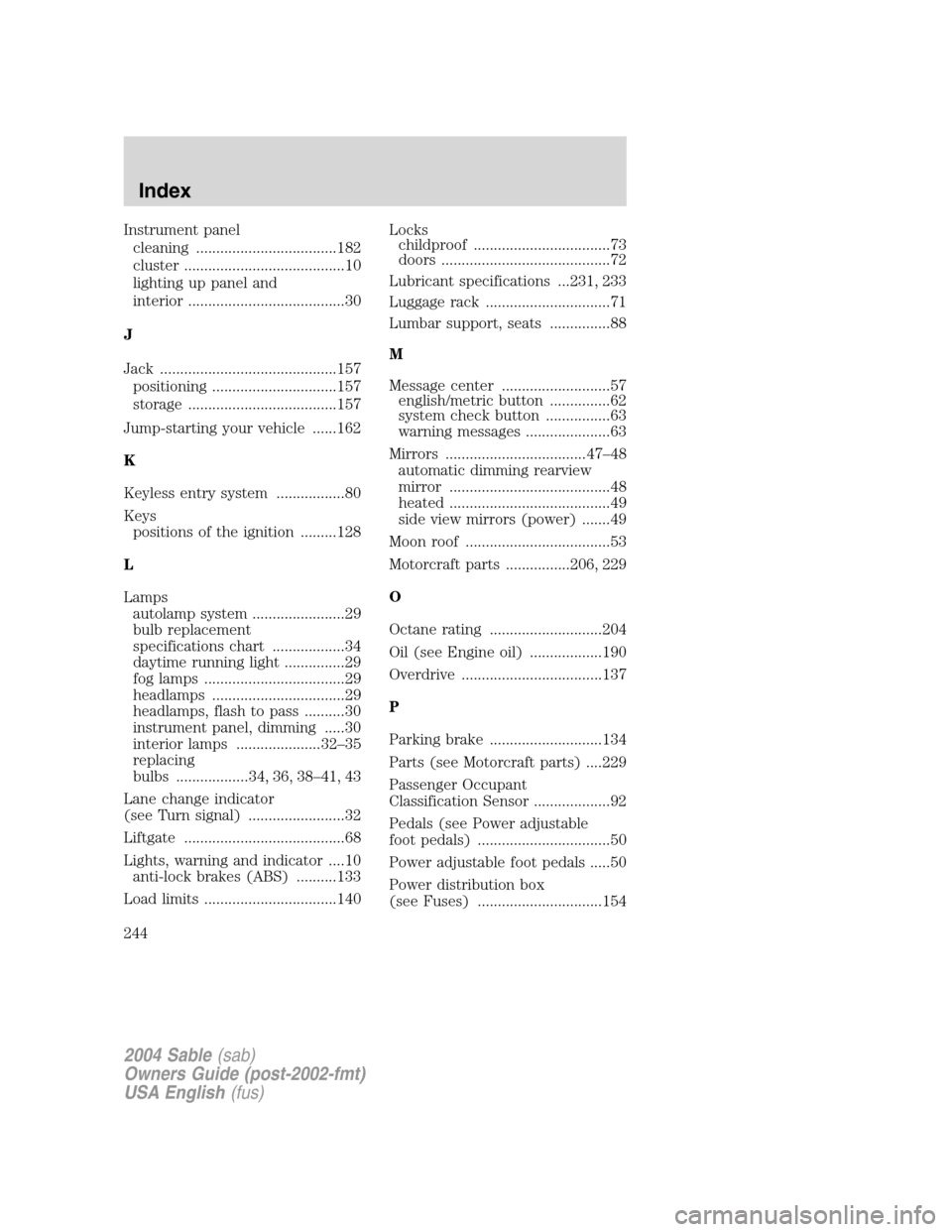octane Mercury Sable 2004 Owner's Manuals
[x] Cancel search | Manufacturer: MERCURY, Model Year: 2004, Model line: Sable, Model: Mercury Sable 2004Pages: 248, PDF Size: 2.28 MB
Page 202 of 248

•Avoid getting fuel liquid in your eyes. If fuel is splashed in the eyes,
remove contact lenses (if worn), flush with water for 15 minutes and
seek medical attention. Failure to seek proper medical attention could
lead to permanent injury.
•Fuels can also be harmful if absorbed through the skin. If fuel is
splashed on the skin and/or clothing, promptly remove contaminated
clothing and wash skin thoroughly with soap and water. Repeated or
prolonged skin contact with fuel liquid or vapor causes skin irritation.
•Be particularly careful if you are taking“Antabuse”or other forms of
disulfiram for the treatment of alcoholism. Breathing gasoline and/or
ethanol vapors, or skin contact could cause an adverse reaction. In
sensitive individuals, serious personal injury or sickness may result. If
fuel is splashed on the skin, promptly wash skin thoroughly with soap
and water. Consult a physician immediately if you experience an
adverse reaction.
•FFV fuel tanks may contain zero to 85 percent ethanol. Any fuel
blends containing gasoline and ethanol should be treated the same as
“Fuel Ethanol”. To identify if your vehicle is an FFV, check your VIN
or the label on the inside of your fuel filler door. When checking the
VIN look for the engine type identifier (8th character). If your vehicle
is an FFV, then the character will be labeled as a“2.”
Pure ethanol is the alcohol which is the intoxicating agent in liquor, beer
and wine. It is distilled from the fermentation of plants such as field corn
and sugar cane. When ethanol is used in the making of motor fuels, a
small amount of a bad tasting chemical is added to discourage beverage
use. The resulting fuel is called E
d100 meaning 100% pure ethanol
diluted by 2% to 5% gasoline as the“denaturant.”
Fuel ethanol (summer blend
d) is then made by adding 15% more
unleaded gasoline. The resulting fuel also has a higher octane rating than
unleaded regular gasoline and other properties which allow engine
designs with greater efficiency and power.
Winter blends may contain up to 30% (E70)unleaded gasoline (25% plus
the denaturant) to enhance cold engine starts. Severely cold weather
may require additional measures for reliable starting. Refer toCold
Weather Startingin theDrivingchapter.
Ethanol is more chemically active than gasoline. It corrodes some metals
and causes some plastic and rubber components to swell, break down or
become brittle and crack, especially when mixed with gasoline. Special
materials and procedures have been developed for flexible fuel vehicles
and the dispensers used by ethanol fuel providers.
2004 Sable(sab)
Owners Guide (post-2002-fmt)
USA English(fus)
Maintenance and Specifications
202
Page 204 of 248

If the“Check Fuel Cap”indicator comes on or if“Service Engine
Soon/Check Engine”indicator comes on and stays on when you start the
engine, the fuel filler cap may not be properly installed. Turn off the
engine, remove the fuel filler cap, align the cap properly and reinstall it.
If you must replace the fuel filler cap, replace it with a fuel filler
cap that is designed for your vehicle. The customer warranty may
be void for any damage to the fuel tank or fuel system if the
correct genuine Ford or Motorcraft fuel filler cap is not used.
The fuel system may be under pressure. If the fuel filler cap is
venting vapor or if you hear a hissing sound, wait until it stops
before completely removing the fuel filler cap. Otherwise, fuel may
spray out and injure you or others.
If you do not use the proper fuel filler cap, excessive pressure or
vacuum in the fuel tank may damage the fuel system or cause
the fuel cap to disengage in a collision, which may result in possible
personal injury.
Choosing the right fuel
Use only UNLEADED FUEL. The use of leaded fuel is prohibited by law
and could damage your vehicle.
If your vehicle is a flexible fuel vehicle (FFV), use only UNLEADED
FUEL and (E85) FUEL ETHANOL. The use of leaded fuel is prohibited
by law and could damage your vehicle.
Do not use fuel containing methanol. It can damage critical fuel system
components.
Your vehicle was not designed to use fuel or fuel additives with metallic
compounds, including manganese-based additives.
Repairs to correct the effects of using a fuel for which your vehicle was
not designed may not be covered by your warranty.
Octane recommendations
Do not be concerned if your engine
sometimes knocks lightly. However,
if it knocks heavily under most
driving conditions while you are
using fuel with the recommended
octane rating, see your dealer or a qualified service technician to prevent
any engine damage.
87(R+M)/2 METHOD
2004 Sable(sab)
Owners Guide (post-2002-fmt)
USA English(fus)
Maintenance and Specifications
204
Page 205 of 248

Unleaded Gasoline engines
Your vehicle is designed to use“Regular”unleaded gasoline with an
(R+M)/2 octane rating of 87. We do not recommend the use of gasolines
labeled as“Regular”that are sold with octane ratings of 86 or lower in
high altitude areas.
FFV engine (if equipped)
Your vehicle is designed to use (E85) Fuel Ethanol,“Regular”unleaded
gasoline or any percentage of the two fuels combined.
U.S. government regulations require fuel ethanol dispensing
pumps to have a small, square, orange and black label with the
common abbreviation or the appropriate percentage for that
region. Use of other fuels such as Fuel Methanol may cause
powertrain damage, a loss of vehicle performance, and your
warranty may be invalidated.
Fuel quality
Many of the world’s automakers approved the World-wide Fuel Charter
that recommends gasoline specifications to provide improved
performance and emission control system protection for your vehicle.
Gasolines that meet the World-wide Fuel Charter should be used when
available. Ask your fuel supplier about gasolines that meet the
World-wide Fuel Charter.
It should not be necessary to add any aftermarket products to your fuel
tank if you continue to use high quality fuel of the recommended octane
rating. Aftermarket products could cause damage to the fuel system.
Repairs to correct the effects of using an aftermarket product in your
fuel may not be covered by your warranty.
Unleaded Gasoline engines
If you are experiencing starting, rough idle or hesitation driveability
problems during a cold start, try a different brand of“Regular”unleaded
gasoline.“Premium”unleaded gasoline is not recommended (particularly
in the United States) because it may cause these problems to become
more pronounced. If the problems persist, see your dealer or a qualified
service technician.
FFV engine (if equipped)
Your FFV will operate well on ordinary“Regular”unleaded gasoline, but
only the highest quality fuel ethanol will provide the same level of
protection and performance. To identify if your vehicle is an FFV, check
your VIN or the label on the inside of your fuel filler door. When
2004 Sable(sab)
Owners Guide (post-2002-fmt)
USA English(fus)
Maintenance and Specifications
205
Page 207 of 248

NOT accurate as a measure of fuel economy. We do not recommend
taking fuel economy measurements during the first 1,600 km (1,000
miles) of driving (engine break-in period). You will get a more accurate
measurement after 3,000 km–5,000 km (2,000 miles-3,000 miles).
Filling the tank
The advertised fuel capacity of the fuel tank on your vehicle is equal to
the rated refill capacity of the fuel tank as listed in theRefill capacities
section of this chapter.
The advertised capacity is the amount of the indicated capacity and the
empty reserve combined. Indicated capacity is the difference in the
amount of fuel in a full tank and a tank when the fuel gauge indicates
empty. Empty reserve is the small amount of fuel remaining in the fuel
tank after the fuel gauge indicates empty.
The amount of usable fuel in the empty reserve varies and should
not be relied upon to increase driving range. When refueling your
vehicle after the fuel gauge indicates empty, you might not be
able to refuel the full amount of the advertised capacity of the
fuel tank due to the empty reserve still present in the tank.
For consistent results when filling the fuel tank:
•Turn the engine/ignition switch to the off position prior to refueling,
an error in the reading will result if the engine is left running.
•Use the same filling rate setting (low—medium—high) each time
the tank is filled.
•Allow no more than 2 automatic click-offs when filling.
•Always use fuel with the recommended octane rating.
•Use a known quality gasoline, preferably a national brand.
•Use the same side of the same pump and have the vehicle facing the
same direction each time you fill up.
•Have the vehicle loading and distribution the same every time.
Your results will be most accurate if your filling method is consistent.
Calculating fuel economy
1. Fill the fuel tank completely and record the initial odometer reading
(in kilometers or miles).
2. Each time you fill the tank, record the amount of fuel added (in liters
or gallons).
3. After at least three to five tank fill-ups, fill the fuel tank and record
the current odometer reading.
2004 Sable(sab)
Owners Guide (post-2002-fmt)
USA English(fus)
Maintenance and Specifications
207
Page 233 of 248

ENGINE DATA
Engine 3.0L V6 Vulcan
engine3.0L FFV V6
engine3.0L DOHC V6
Duratec engine
Cubic inches 182 182 181
Required fuel 87 octane 87 octane or
Ethanol (E 85)87 octane
Firing order 1-4-2-5-3-6 1-4-2-5-3-6 1-4-2-5-3-6
Ignition system EDIS EDIS Coil on plug
Compression
ratio9.7:1 9.7:1 10.0:1
VEHICLE DIMENSIONS
Vehicle dimensions Sedan mm (in) Wagon mm (in)
(1) Overall length 5075 (199.9) 506 9.8 (197.8)
(2) Overall width 1854 (73.0) 1854.2 (73.0)
(3) Overall height 1463 (57.6) 1468 (57.8)
(4) Wheelbase 2757 (108.5) 2757 (108.5)
(5) Track - Front 1566 (61.6) 1566 (61.6)
(5) Track - Rear 1577.0 (62.1) 1570 (61.8)
2004 Sable(sab)
Owners Guide (post-2002-fmt)
USA English(fus)
Maintenance and Specifications
233
Page 243 of 248

dipstick ....................................190
filter, specifications ........193, 229
recommendations
...................193
refill capacities
........................230
specifications
..................231, 233
Exhaust fumes
..........................132
F
Flexible Fuel Vehicle (FFV)
....201
Floor mats
...................................67
Fluid capacities
.........................230
Foglamps
.....................................29
Fuel
............................................201
calculating fuel
economy
............................59, 206
cap
...........................................203
capacity
...................................230
choosing the right fuel
...........204
comparisons with EPA fuel
economy estimates
.................209
detergent in fuel
.....................206
filling your vehicle with
fuel
...........................201, 203, 207
filter, specifications
........206, 229
fuel pump shut-off switch
.....149
improving fuel economy
........206
octane rating
...................204, 233
quality
......................................205
running out of fuel
.................206
safety information relating
to automotive fuels
................201
Fuel - flex fuel vehicle
(FFV)
.................................201, 204
Fuses
..........................................151G
Garage Door Opener
(see Homelink wireless control
system) ........................................53
Gas cap (see Fuel cap) ............203
Gas mileage (see Fuel
economy) ...................................206
Gauges .........................................13
H
Hazard flashers .........................149
Headlamps ...................................29
aiming ........................................31
autolamp system .......................29
bulb specifications ....................34
daytime running lights .............29
flash to pass ..............................30
high beam .................................30
replacing bulbs .........................36
turning on and off ....................29
Heating
heating and air conditioning
system .................................23, 25
HomeLink universal
transceiver (see Garage door
opener) ........................................57
Homelink wireless control
system ..........................................53
Hood ..........................................186
I
Ignition ...............................128, 233
Infant seats
(see Safety seats) .....................118
Inspection/maintenance (I/M)
testing ........................................211
2004 Sable(sab)
Owners Guide (post-2002-fmt)
USA English(fus)
Index
243
Page 244 of 248

Instrument panel
cleaning ...................................182
cluster ........................................10
lighting up panel and
interior .......................................30
J
Jack ............................................157
positioning ...............................157
storage .....................................157
Jump-starting your vehicle ......162
K
Keyless entry system .................80
Keys
positions of the ignition .........128
L
Lamps
autolamp system .......................29
bulb replacement
specifications chart ..................34
daytime running light ...............29
fog lamps ...................................29
headlamps .................................29
headlamps, flash to pass ..........30
instrument panel, dimming .....30
interior lamps .....................32–35
replacing
bulbs ..................34, 36, 38–41, 43
Lane change indicator
(see Turn signal) ........................32
Liftgate ........................................68
Lights, warning and indicator ....10
anti-lock brakes (ABS) ..........133
Load limits .................................140Locks
childproof ..................................73
doors ..........................................72
Lubricant specifications ...231, 233
Luggage rack ...............................71
Lumbar support, seats ...............88
M
Message center ...........................57
english/metric button ...............62
system check button ................63
warning messages .....................63
Mirrors ...................................47–48
automatic dimming rearview
mirror ........................................48
heated ........................................49
side view mirrors (power) .......49
Moon roof ....................................53
Motorcraft parts ................206, 229
O
Octane rating ............................204
Oil (see Engine oil) ..................190
Overdrive ...................................137
P
Parking brake ............................134
Parts (see Motorcraft parts) ....229
Passenger Occupant
Classification Sensor ...................92
Pedals (see Power adjustable
foot pedals) .................................50
Power adjustable foot pedals .....50
Power distribution box
(see Fuses) ...............................154
2004 Sable(sab)
Owners Guide (post-2002-fmt)
USA English(fus)
Index
244